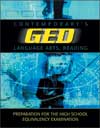|
 |  Contemporary's GED Language Arts, Reading John M. Reier
Comprehension
Chapter OutlineStudy the chapter outline below. Use the page numbers below each topic to refer to the corresponding section in Contemporary's GED Language Arts, Reading. When you are finished, go to the Flashcards or choose a different activity or chapter from the menu on the left.
Comprehension
(See page 15)
Comprehension is the skill of understanding what a passage is directly saying. |
 |  |  | Recognizing Supporting Details
(See pages 23–30)
The main idea in a passage or the topic sentence in a paragraph is always backed up by supporting details: - They provide additional information that develops the main idea.
- They are specific statements relating to the passage’s central message.
- They provide a more complete picture of what the author is saying.
There are four types of supporting details:
1. Supporting examples - illustrate or explain the main idea
- show the meaning of a general statement
2. Supporting reasons - describe a viewpoint, an opinion, or an action
3. Supporting facts - explain detailed information
- explain accurate information
- persuade readers to agree with the author
- persuade readers to take a particular action
4. Supporting descriptions - help the reader visualize a person, place, object or event
|
|
|



 2002 McGraw-Hill Higher Education
2002 McGraw-Hill Higher Education